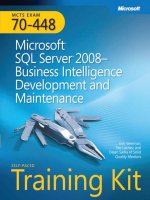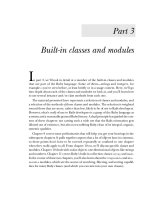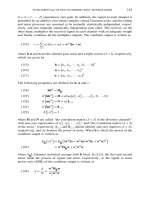Microsoft Data Mining integrated business intelligence for e commerc and knowledge phần 6 pdf
Bạn đang xem bản rút gọn của tài liệu. Xem và tải ngay bản đầy đủ của tài liệu tại đây (822.64 KB, 34 trang )
150 5.10 The tree navigator
Figure 5.46 shows that males who have an relatively long tenure (≥
1.125 years) and who come from relatively small firms (≤ 0.25) or, at the
other extreme, from relatively large firms (> 1.75) are most likely to attend:
7.6 percent. This places this group at about the same level as the overall
attendance rate of 10 percent and indicates that these people can be tar-
geted as a means of increasing loyalty and lifetime value.
As shown in Figure 5.47, females who come from firms with relatively
low annual sales and who come from a midrange size of firm (> 1.75 and
≤ 3.25) are also good targets. This group had an attendance rate of 14.85
percent. Notice that there are only 14 “positive” occurrences of attendance
Figure 5.46 Increased response among males with high tenure
Figure 5.47 Example of response by selected female attributes
5.11 Clustering (creating segments) with cluster analysis 151
Chapter 5
in this node. This is a relatively small number to base results on, even
though these results are statistically valid.
There are no attendances in the Annual Sales > 1.25 node and in the
Size of Firm ≤ 1.75 or > 3.25 node, shown in Figure 5.48. We see that there
are only 6 of 724 “positive” cases (less than 1 percent). Six cases is a very
small number to base marketing results on and, while it may be possible to
demonstrate that the results are statistically valid from a theoretical point of
view, it is definitely recommended to verify these results with respect to a
holdout sample or validation database to see whether these results could be
expected to generalize to a new marketing target population.
5.11 Clustering (creating segments) with
cluster analysis
Cluster analysis allows us to segment the target population reflected in our
database on the basis of shared similarities among a number of attributes.
So, unlike decision trees, it is not necessary to specify a particular outcome
to be used to determine various classes, discriminators, and predictors.
Rather, we just need to specify which fields we want the data mining clus-
tering algorithm to use when assessing the similarity or dissimilarity of the
cases being considered for assignment to the various clusters.
To begin the data mining modeling task it is necessary to specify the
source data. As with the decision tree, developed in the previous section, we
will point the Data Mining wizard at the Conferences.mdb data source and
pick up the customer table as the analysis target. As shown in Figure 5.49,
in this case we will be clustering on customers and will use their shared sim-
ilarities according to various characteristics or attributes to determine to
which cluster they belong.
Figure 5.48 A small number of “positive” cases
152 5.11 Clustering (creating segments) with cluster analysis
Figure 5.49
Identifying the
source table to serve
as the clustering
target
Figure 5.50
Selecting the cluster
data mining
method
5.11 Clustering (creating segments) with cluster analysis 153
Chapter 5
Once the target data table has been identified, the Modeling wizard will
request us to specify the data mining technique. As shown in Figure 5.50,
select clustering as the data mining method.
As in all data mining models, we are asked to indicate the level of analy-
sis. This is contained in the case key selected for the analysis. As shown in
Figure 5.51, at this point we want the level of analysis to be the customer
level, so we specify the customer as the key field.
The Analysis wizard then asks us to specify the fields that will be used to
form the clusters. These are the fields that will be used to collectively gauge
the similarities and dissimilarities between the cases to form the customer
clusters. We select the fields shown in Figure 5.52.
Once the fields have been selected, we can continue to run the cluster
model. After processing, we get the results presented in Figure 5.53.
Figure 5.51
Selecting the case
key to define the
unit of analysis
Figure 5.52
Selecting the fields
to use in
calculating
similarity measures
to define the
clusters
154 5.11 Clustering (creating segments) with cluster analysis
In Figure 5.53 we see that by default, the cluster procedure has identified
ten clusters. The content detail and content navigator areas use color to rep-
resent the density of the number of observations.
We can browse the attribute results to look at the characteristics of the
various clusters. Although we can be confident that the algorithm has
forced the clusters into ten homogenous but optimally distinct groups, if we
want to understand the characteristics of the groups then it may be prefera-
ble to tune the clustering engine to produce a fewer number of clusters.
Three clusters accomplish this. There are many different quantitative tests
to determine the appropriate number of clusters in an analysis. In many
cases, as illustrated here, the choice is made on the basis of business knowl-
edge and hunches on how many distinct customer groupings actually exist.
Having determined that three clusters are appropriate, we can select the
Figure 5.53 Default display produced by the cluster analysis modeling procedure
5.11 Clustering (creating segments) with cluster analysis 155
Chapter 5
Figure 5.54
Using the
properties dialog to
change the number
of clusters
Figure 5.55 Identification of three clusters resulting from changes to the number of cluster
properties
156 5.11 Clustering (creating segments) with cluster analysis
properties dialog and change the number of clusters from ten to three. This
is shown in Figure 5.54.
This will instruct Analysis Server to recalculate the cluster attributes and
members by trying to identify three clusters rather than the default ten clus-
ters. To complete this recalculation you need to go back to the data mining
model, reprocess the model, and then browse the model to see the new
results. The new results are displayed in Figure 5.55.
As shown in Figure 5.55, the attributes pane shows which decision rules
can be used to characterize the cluster membership. Each decision rule will
result in classifying a case into a unique cluster. The cluster that is found
will depend upon how the preconditions of the cluster decision rule match
up to the specific attributes of the case being classified.
Here are the decision rules for classifying cases (or records) into the three
clusters. Note that the fields used as preconditions of the decision rule are
the same fields we indicated should be used to calculate similarity in the
Mining Model wizard.
Cluster 1. Size Of Firm = 0 ,
Annual Sales = 0 ,
0.100000001490116 ≤ Tenure ≤ 1.31569222413047 ,
Gender = M
Cluster 2. 6.65469534945513 ≤ Size Of Firm ≤ 9 ,
1.06155892122041 ≤ Annual Sales ≤ 9 ,
0.100000001490116 ≤ Tenure ≤ 3.00482080240072 ,
Gender = F
Cluster 3. Size Of Firm ≤ 0 ,
Tenure ≤ 0.100000001490116 ,
0 ≤ Annual Sales ≤ 5.18296067118255 ,
Gender = F
5.11.1 Customer segments as revealed by
cluster analysis
These decision rules provide a statistical summary of the cases in the data
set once they have been classified in the various clusters. Here we can see
that Cluster 1 characterizes customers from generally small, general low
sales volume firms. Cluster 1 members also have generally short tenure.
Cluster 3 is primarily a female cluster and has the very short tenure mem-
5.11 Clustering (creating segments) with cluster analysis 157
Chapter 5
bers while Cluster 2 draws on customers from the larger, high sales volume
firms.
This tends to suggest that we have Small, low sales volume customers
who tend to be males. Among female customers they are either longer term
customers from generally larger, higher sales companies or very short term
customers from small, medium sales companies.
We can see here that Cluster techniques and Decision Tree techniques
produce different kinds of results: the decision tree was produced purely
with respect to probability of response. The Clusters, on the other hand, are
produced with respect to Tenure, Gender, Size of Firm and Annual Sales. In
fact, in clustering, probability of response was specifically excluded.
5.11.2 Opening (refreshing) mining models
As indicated in Chapter 3, mining models are stored as Decision Support
Objects in the database. The models contain all the information necessary
to recreate themselves, but they need to be refreshed in order to respond to
new data or new settings. To retrieve a previously grown mining model, go
to Analysis Services and select the mining model you want to look at. For
example, as shown in Figure 5.56, open the Analysis Server file tree and
highlight the previously produced mining model entitled “PromoResults.”
Go to the Action menu or right-click the mouse and execute Refresh.
This will bring the mining results back. Once the model is refreshed, go to
the Action menu and select Browse to look at the model results.
Figure 5.56
Navigating to the
Analysis Services
tree to retrieve a
data mining model
158 5.12 Confirming the model through validation
5.12 Confirming the model through validation
It is important to test the results of modeling activities to ensure that the
relationships that have been uncovered will bear up over time and will hold
true in a variety of circumstances. This is important in a target marketing
application, for example, where considerable sums will be invested in the
targeting campaign. This investment is based on the model results, so they
better be right! The best way to determine whether a relationship is right or
not is to see whether it holds up in a new set of data drawn from the mod-
eled population. In essence, in a target marketing campaign, we would like
to apply the results of the analysis to a new set of data, where we already
know the answer (whether people will respond or not), to see how well our
model performs.
This is done by creating a “test” data set (sometimes called a “hold back”
sample), which is typically drawn from the database to be analyzed before
the analytical model is developed. This way we can create a test data set that
hasn’t been used to develop the model. We can see that this test data set is
independent of the training (or learning data set), so it can serve as a proxy
for how a new data set would perform in a model deployment situation. Of
course, since the test data set was extracted from the original database, it
contains the answer; therefore, it can be used to calculate the validity of the
model results. Validity consists of accuracy and reliability: How accurately
do we reproduce the results in a test data set and how reliable is this finding.
Reliability is best tested with numerous data sets, drawn in different sets of
circumstances over time. Reliability accumulates as we continue our model-
ing and validation efforts over time. Accuracy can be calculated on the basis
of the test data set results.
5.12.1 Validation with a qualitative question
Qualitative questions—such as respond/did not respond—result in decision
trees where the components of the nodes on the branches of the tree show a
frequency distribution (e.g., 20 percent respond; 80 percent do not
respond). In this case the decision tree indicates that the majority of cases
will not respond. To validate this predicted outcome a test or hold back
sample data set is used. Each data record in the test sample is validated
against the prediction that is suggested by the decision tree. If the predic-
tion is correct, then the valid score indicator is incremented. If the
prediction is incorrect, then the invalid score indicator is incremented. At
the end of the validation procedure the percentage of valid scores to invalid
5.13 Summary 159
Chapter 5
scores is calculated. This is then displayed as the percentage accuracy of the
validated decision tree model.
5.12.2 Validation with a quantitative question
In the case of a quantitative outcome, such as dollars spent, accuracy can be
calculated using variance explained according to a linear regression model
calculated in a standard statistical manner. In this case, some of the superior
statistical properties of regression are used in calculating the accuracy of the
decision tree. This is possible because a decision tree with quantitative data
summarized in each of the nodes of the decision tree is actually a special
type of regression model. So the statistical test of variance explained, nor-
mally used in regression modeling, can be used with decision trees.
Thus, the value of a quantitative field in any given node is computed as
consisting of the values of the predictors multiplied by the value for each
predictor that is derived in calculating the regression equation. In a perfect
regression model this calculation will equal the observed value in the node
and the prediction will be perfect. When there is less than a perfect predic-
tion, the observed value deviates from the predicted value. The deviations
from these scores, or residuals, represent the unexplained variance of the
regression model.
The accuracy that you find acceptable depends upon the circumstances.
One way to determine how well your model performs is to compare its per-
formance with chance. In our example, there were about 67 percent, or
two-thirds, responders and about one-third nonresponders. So, by chance
alone, we expect to be able to correctly determine whether someone
responds two-thirds of the time. Clearly then, we would like to have a
model that provides, say, an 80 percent accuracy rate. This difference in
accuracy—the difference between the model accuracy rate of 80 percent
and the accuracy rate given by chance (67 percent)—represents the gain
from using the model. In this case the gain is about 13 percent. In general,
this 13 percent gain means that we will have lowered targeting costs and
increased profitability from a given targeting initiative.
5.13 Summary
Enterprise data can be harnessed—profitably and constructively—in a
number of ways to support decision making in a wide variety of problem
areas. The “trick” is to deploy the best pattern-searching tools available to
160 5.13 Summary
look through the enterprise data store in order to find all relevant data
points to support a decision and, more importantly, to determine how these
data points interact with one another to affect the question under examina-
tion.
This is where decision tree products show their value as an enterprise
data and knowledge discovery tool. Decision trees search through all rele-
vant data patterns—and combinations of patterns—and present the best
combinations to the user in support of decision making. The decision tree
algorithm quickly rejects apparent (spurious) relationships and presents
those combinations of patterns that—together—produce the effect under
examination. It is both multidimensional, in an advanced numerical proc-
essing manner, and easy to use in its ability to support various user models
of the question under examination.
In summary, the SQL 2000 decision tree presents critical benefits in
support of the enterprise knowledge discovery mission, as follows:
It is easy to use and supports the user’s view of the problem domain.
It works well with real-world enterprise data stores, including data
that are simple, such as “male” and “female,” and data that are com-
plex, such as rate of investment.
It is sensitive to all relevant relationships, including complex, multiple
relationships, yet quickly rejects weak relationships or relationships
that are spurious (i.e., relationships that are more apparent than real).
It effectively summarizes data by forming groups of data values that
belong together in clusters, or branches, on the decision tree display.
It employs advanced statistical hypothesis testing procedures and vali-
dation procedures to ensure that the results are accurate and repro-
ducible (in a simple manner, behind the scenes, so that users do not
need a degree in statistics to use these procedures).
The resulting display can be quickly and easily translated into deci-
sion rules, predictive rules, and even knowledge-based rules for
deployment throughout the enterprise.
In a similar manner, the SQL 2000 clustering procedure provides critical
benefits when a particular field or outcome does not form the focus of the
study. This is frequently the case when, for example, you are interested in
placing customers into various classes or segments that will be used to
describe their behavior in a variety of circumstances. As with the decision
5.13 Summary 161
Chapter 5
tree, the cluster procedure provides a range of benefits, including the fol-
lowing:
The Data Mining wizard makes it easy to use.
It is possible to define, ahead of time, how many clusters you feel are
appropriate to describe the phenomenon (e.g., customer segments)
that you are viewing.
The attributes of the clusters can be easily examined.
As with decision tree models, cluster models can be described and
deployed in a variety of ways throughout the enterprise.
Knowledge discovery is similar to an archeological expedition—you
need to sift through a lot of “dirt” in order to find the treasure buried
beneath the dig. There is no shortage of dirt in enterprise operational data,
but there are real treasures buried in the vaults of the enterprise data store.
The SQL Server 2000 decision tree is an indispensable tool for sifting
through multitudes of potential data relationships in order to find the criti-
cal patterns in data that demonstrate and explain the mission-critical princi-
ples necessary for success in the knowledge-based enterprise of the twenty-
first century.
This Page Intentionally Left Blank
163
6
Deploying the Results
The customer generates nothing. No customer asked for electric lights.
—W. Edwards Deming
W. Edwards Deming, in his tireless efforts to apply statistical concepts in
the pursuit of ever-more quality outputs, was instrumental in changing the
way products are conceived, designed, and developed. In the Deming
model, novelty emerged from the determined application of quality princi-
ples throughout the product life cycle. The Deming quality cycle is similar
to the data mining closed-loop “virtuous cycle,” which was outlined in
Chapter 2. The application of data mining results, and the lessons to be
learned from the application of these results to the product/market life
cycle, begins with the deployment of the results. In the same way that tire-
less application of quality principles throughout the product life cycle has
been shown to lead to revolutionary new ways of conceiving, designing, and
delivering products, so too can the tireless deployment of data mining
results to market interventions lead to similar revolutionary developments
in the product and marketing life cycle.
If information is data organized for decision making, then knowledge
could be termed data organized for a deployable action. As seen in the
example developed in Chapter 5, data, once analyzed, yield up their secrets
in the form of a decision rule, a probability to purchase, or perhaps a cluster
assignment. The deployment of the decision rule, probability to purchase,
or cluster assignment could be embodied in a specific, point solution to a
particular problem (e.g., identify cross-sell opportunities on a Web site or at
164 6.1 Deployments for predictive tasks (classification)
a customer call center). Another deployment could be a multistage, multi-
channel delivery system (e.g., in what is normally referred to as campaign
management, send offers to prospects through several channels with various
frequencies and periodicities while measuring the results in order to deter-
mine not only what characteristics of prospects are most likely to lead to
responses but which approach methods, frequencies, and timing provide
incremental response “lift”). In assessing the potential value of a deployable
result, it is common to talk about lift. Lift is a measure of the incremental
value obtained by using the data mining results when compared with the
results that would normally be achieved in the absence of using the knowl-
edge derived from data mining.
In this chapter, we will show how to implement a target marketing
model by scoring the customer database with a predictive query. We also
show how to estimate return on investment with a lift chart.
6.1 Deployments for predictive
tasks (classification)
Data Transformation Services (DTS), which are located in the Enterprise
Services of SQL Server 2000, can be used to build a prediction query to
score a data set using a predictive model developed in Analysis Manager.
The predictive query is used to score unseen cases and is stored as a DTS
package. This package can be scheduled for execution using DTS to trigger
the package at any time in the future, under a variety of conditions. This is
a very powerful way to create knowledge about unclassified cases, customers
who have responded to a promotional offer, or customers who have visited
your Web site.
Figure 6.1 illustrates the procedure that is necessary to create a predic-
tion query. First, start up DTS Designer by going to the desktop start
menu, selecting Programs, pointing to Microsoft SQL Server, and then
selecting Enterprise Manager. In the console tree, expand the server that will
hold the package containing the Data Mining Prediction Query task.
Right-click the Data Transformation Services folder, and then click New
Package.
In DTS Designer, from the Task tool palette, drag the icon for the Data
Mining Prediction Query task onto the workspace. This icon appears in the
DTS Package (New Package) dialog shown in Figure 6.1.
As an option, as shown in Figure 6.1, in the Data Mining Prediction
Query Task dialog box, type a new name in the Name box to replace the
6.1 Deployments for predictive tasks (classification) 165
Chapter 6
default name for the task. As another option, type a task description in the
Description box. This description is used to identify the task in DTS
Designer. In the Server box, type the name of the Analysis Server containing
the data mining model to be used as the source for the prediction query.
The server name—MetaGuide, used in the example in Figure 6.1—is the
same as the computer name on the network.
From the Database list, select the database that contains the mining
model to be queried. Here we select ConferenceResults, and this provides
either the CustomerSegments data mining model (DMM) for the cluster
results or PromoResults DMM for the response analysis.
If the mining model you want to use for the prediction query is not
already highlighted in the Mining Models box, select a mining model from
the box by clicking on its name or icon. As shown in Figure 6.1, you can
view some of the properties of the mining model in the Details box.
Click the Query tab, and then, in the Data source box, either type a
valid ActiveX Data Objects (ADOs) connection string to the case table con-
taining the input and predictable columns for the query, or, to build the
connection string, click the edit ( ) button to launch the Data Link Prop-
erties dialog box.
Figure 6.1 Building a prediction query task in DTS Designer
166 6.1 Deployments for predictive tasks (classification)
In the Prediction query box, type the syntax, or click New Query to
launch Prediction Query Builder, as shown in Figure 6.2. If you choose to
build the query yourself, note that the prediction query syntax must con-
form to the OLE DB for DM specification. For more information about the
OLE DB for DM specification, see the list of links on the SQL Server Docu-
mentation Web site at />As shown in Figure 6.2, once the Prediction Query Builder has
launched, you can build a query. The query asks you to associate the predic-
tion with a new table.
Once the associations are made, the query builder is complete, and you
can click OK to finish creating the task.
When the query is executed, it produces the query code shown in the
query output box, displayed in Figure 6.3.
As can be seen by examining the code produced by the Prediction Query
Builder, prediction queries are run by means of the SELECT statement.
The prediction query syntax is as follows:
SELECT [FLATTENED] <SELECT-expressions> FROM <mining
model name>
PREDICTION JOIN <source data query> ON <join condition>
[WHERE <WHERE-expression>]
Figure 6.2
DTS Prediction
Query Builder
6.1 Deployments for predictive tasks (classification) 167
Chapter 6
The <mining model name> identifies the mining model that will be
used to generate the predictions. After the source data have been identified,
a relationship between these data and the data in the mining model must be
defined. This is done using the PREDICTION JOIN clause. The <source
data query> token identifies the set of new cases that will be predicted. As
seen in the code, the mining model entitled PromoResults will be used to
generate new values for the ID, Tenure, and Gender fields.
The query language shown in Figure 6.3, which will be stored as a DTS
package, is as follows:
SELECT FLATTENED
[T1].[Fid], [T1].[Tenure], [T1].[Gender], [T1].[Size Of
Firm], [T1].[Annual Sales], [T1].[Outcome],
[PromoResults].[Outcome]
FROM
[PromoResults]
PREDICTION JOIN
OPENROWSET(
'MSDataShape',
'Data Provider=MSDASQL.1;Persist Security
Info=False;Data Source=MS Access Database',
'SHAPE {SELECT 'ID' AS 'Fid', 'Tenure', 'Gender',
'SizeOfFirm' AS 'Size Of Firm', 'Annual Sales', 'Attend'
Figure 6.3
Running the
prediction query
task with
Prediction Query
Builder
168 6.1 Deployments for predictive tasks (classification)
AS 'Outcome' FROM 'Customers' ORDER BY 'ID'}'
) AS [T1]
ON
[PromoResults].[Fid] = [T1].[Fid] AND
[PromoResults].[Tenure] = [T1].[Tenure] AND
[PromoResults].[Gender] = [T1].[Gender] AND
[PromoResults].[Size Of Firm] = [T1].[Size Of Firm] AND
[PromoResults].[Annual Sales] = [T1].[Annual Sales] AND
[PromoResults].[Outcome] = [T1].[Outcome]
In the Data Mining Prediction Query dialog you can select the Output
tab to define an outcome data source, as shown in Figure 6.4.
As shown in Figure 6.4, the results of the prediction query task are going
to be produced in a new table entitled PredictionResults. Click OK to finish
creating the task. To save the task in a DTS package in DTS Designer, click
Save on the package menu. Figure 6.4 shows the result of this save opera-
tion.
As shown in Figure 6.5, you can save the package in the following four
ways:
1. As a Microsoft SQL Server table. This allows you to store packages
on any instances of SQL Server on your network. This is the
option used in Figure 6.5.
Figure 6.4
Defining the
output data source
for the prediction
query task
6.1 Deployments for predictive tasks (classification) 169
Chapter 6
2. SQL Server 2000 metadata services. With this save option, you can
maintain historical information about the data manipulated by
the package and you can track the columns and tables used by the
package as a source or destination.
3. As a structured storage file. With this save option, you can copy,
move, and send a package across the network without having to
store the file in a SQL Server database.
4. As a Microsoft Visual BASIC file. This option scripts out the pack-
age as Visual BASIC code; you can later open the Visual BASIC
file and modify the package definition to suit your specific pur-
poses.
Once the package is saved, as shown in Figure 6.5, it can be saved and
executed according to a defined schedule or on demand from the DTS Pre-
diction Package window. To execute, click on the prediction icon and trig-
ger the Execute Step selection. This will create an execution display, as
shown in Figure 6.6.
Once the predictive query has been run, you will be notified that the
task has completed successfully. This is illustrated in Figure 6.7.
If you were to go to the data table that was classified with the predictive
model (here the table has been defined as PredictionResults), you would
find the results shown in Table 6.1.
In Table 6.1, we see that the PromoResults_Outcome column has been
added by the predictive query engine.
Figure 6.5
Saving the query
prediction package
in DTS
170 6.1 Deployments for predictive tasks (classification)
If we append the actual attendance score recorded for this data set and
sort the columns by predicted attendance, the results would be as shown in
Table 6.2.
Figure 6.6
DTS package
execution
Figure 6.7 Notification of successful package execution
6.1 Deployments for predictive tasks (classification) 171
Chapter 6
Table 6.1 Prediction Results Table Created by the Prediction Query Task
T1_Fid T1_Tenure T1_Gender T1_Size of Firm T1_Annual Sales PromoResults_Outcome
12.1M000
22M000
34.2M000
42.2M000
53.1M000
64.1M000
72.1M000
82.1F000
93.1M000
10 2.1 F 0 0 0
11 3.1 M 0 0 0
12 4.2 M 0 0 0
Table 6.2 Results of the Prediction (PromoResults_Outcome) and Actual Results
T1_Fid T1_Tenure T1_Gender T1_Size of Firm T1_Annual Sales PromoResults_Outcome Actual
2523 0.1 M 9 6 1 1
2526 0.1 M 3 2 1 1
2534 0.1 M 3 0 1 1
2536 0.1 M 9 9 1 1
2545 0.1 M 0 0 1 1
2625 0.1 M 0 0 1 1
2626 0.1 M 0 0 1 1
2627 0.1 M 0 0 1 1
2628 0.1 F 0 0 1 1
2629 0.1 M 0 0 1 1
2630 0.1 M 7 4 1 1
172 6.2 Lift charts
Overall, in this data set there were 604 occurrences of an attendance and
the predictive query correctly classified 286 of these. So the overall atten-
dance rate is 14.7 percent (604 of 4,103 cases), and the predictive model
correctly classified 47.4 percent of these (286 of 604 positive occurrences).
These types of results are very useful in targeted marketing efforts.
Under normal circumstances it might be necessary to target over 30,000
prospects in order to get 5,000 attendees to an event where the expected
response rate is 14.7 percent. With a 47.4 percent response rate this reduces
the number of prospects that have to be targeted to slightly over 10,000.
6.2 Lift charts
Lift charts are almost always used when deploying data mining results for
predictive modeling tasks, especially in target marketing. Lift charts are use-
ful since they show how much better your predictive model is when com-
pared with the situation where no modeling information is used at all. It is
common to compare model results with no model (chance) results in the
top 10 percent of your data, top 20 percent, and so on. Typically, the model
would identify the top 10 percent that is most likely to respond. If the
model is good, then it will identify a disproportionate number of respond-
ers in the top 10 percent. In this way it is not uncommon to experience
model results in the top 10 percent of the data set that are two, three, and
even four or more times likely to identify respondents than would be found
with no modeling results.
Lift charts are used to support the goals of target marketing: to produce
better results with no increase in budget and to maintain results with a bud-
get cut (target fewer, but better chosen, prospects).
Data mining predictive models can be used to increase the overall
response rate to a target marketing campaign by only targeting those pros-
pects who, according to the data mining model developed with historic
results, are most likely to respond. The lift chart in Figure 6.8 illustrates the
concept.
In Figure 6.8, we show a lift chart that results when all prospects on the
database are assigned a score developed by the predictive model decision
tree. This score is probability of response. So every member of the database
has a score that ranges from 0 (no response) to 1 (100 percent likely to
respond). Then the file is sorted so that the high probabilities of response
prospects are ranked at the head of the file and the low probabilities of
response prospects are left to trail at the end of the file.
6.2 Lift charts 173
Chapter 6
If the data mining model is working, then the data mining scoring
should produce more responders in, say, the top 10 percent than the average
response rate for all members in the data file. The lift chart shows how well
the predictive model works. In the lift chart let us assume that the overall
response rate is 10 percent. This overall response rate is reflected in the
diagonal line that connects the origin of the graph to the upper right quad-
rant. If the data mining results did not find characteristics in the prospect
database that could be used to increase knowledge about the probability to
respond to a targeting campaign, then the data mining results would track
the random results and the predicted response line would overlap the lower
left to upper right random response line.
In most cases, the data mining results outperform the random baseline.
This is illustrated in our example in Figure 6.8. We can see that the first 5
percent of the target contacts collected about 9 percent of the actual
responses. The next increment on the diagonal—moving the contacts to 10
percent of the sample—collects about 12 percent of the responses and so
on. By the time that 25 percent of the sample has been contacted we can see
that 40 percent of the responses have been captured. This represents the
cumulative lift at this point. This is a ratio of 40:25, which yields a lift of
1.6. This tells us that the data mining model will enable us to capture 1.6
times the normal expected rate of response in the first 25 percent of the tar-
geted population.
The lift chart for the query shown in Table 6.2 is displayed in Figure 6.9.
With a good predictive model it is possible to improve the performance,
relative to chance, by many multiples. This example shows the kind of lift
Figure 6.8
Lift chart showing
cumulative
captured response
174 6.2 Lift charts
that can be expected if, instead of only capturing a response rate of about 10
percent, you capture a response rate of approximately 50 percent. The sec-
ond 20 percent of the example shows that approximately two-thirds of the
responses have been captured. The overall response rate was about 19 per-
cent, which means that the first two deciles produce lift factors of 5:1 and
3:1, respectively. Using the results of the first 20 percent would mean that a
targeting campaign could be launched that would produce two-thirds of the
value at one-fifth of the cost of a campaign that didn’t employ data mining
results. This provides a dramatic illustration of the potential returns
through the construction of a data mining predictive model.
Figure 6.9
Lift chart for
predictive query
Figure 6.10
Backing up and
restoring the
database









